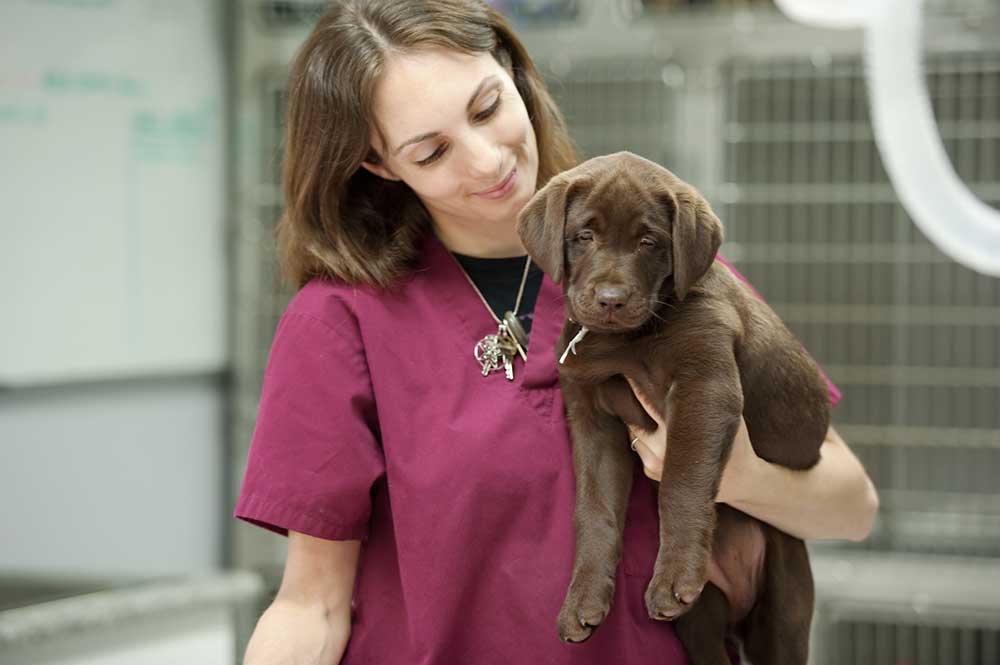Disclaimer: The information on our website is provided for general information purposes only. We make no representations or warranties of any kind, express or implied, about the completeness, accuracy, reliability, suitability or availability with respect to the website or the information contained on our website for any purpose. Any reliance on such information is therefore strictly at your own risk and we are not liable for any damages or losses arising out of or resulting from your reliance on any information contained on our website.
A veterinarian assistant cares for the well-being of animals in animal hospitals, clinics, or laboratories. This includes feeding, bathing, exercising, and monitoring animals in their care. Additionally, they monitor animals after surgery and assist a veterinarian in a variety of other duties. Watch a video to learn what a veterinarian assistant does:
How to Become a Veterinarian Assistant

Most employers expect a veterinarian assistant to have at least a high school diploma. From there, employers will provide your on-the-job training. Many hiring managers prefer applicants that have experience working with animals. Therefore, it may be helpful to volunteer at a local animal shelter or animal rescue organization. Though not required for employment, some veterinarian assistants choose to earn certifications to advance their career opportunities after gaining experience. These certifications can be earned through the National Association of Veterinary Technicians in America (NAVTA) or the American Association for Laboratory Animal Science. Most certificate programs usually take a year or less.
There are a variety of options to complete these certifications. NAVTA has a list of Online programs, High School Campus programs, and Adult Campus programs. Information on eligibility and the application process can be found on NAVTA’s website at Veterinary Assistant Programs. According to O*NET Online, some veterinarian assistants surveyed have taken some college classes and many have earned an associate’s degree. Associate’s degree programs generally take two years to complete. You will want to look for programs that include basic medical care, anatomy, physiology, and vet terminology.
Job Description of a Veterinarian Assistant
A veterinarian assistant performs a variety of tasks under the supervision of a vet. For example, they sterilize surgical instruments and equipment as well as feed, bathe, exercise, and weigh animals. They are most often found working in clinics, animal hospitals, and laboratories. Because of the nature of the job, they may work a variety of hours including nights, weekends, and holidays.
These workers must also restrain animals during an examination or laboratory procedure and provide medication or immunizations prescribed by the veterinarian. Additionally, they may assist in collecting, urine, blood and tissue samples of the animal. They would monitor and care for an animal after any surgical procedure. This job can be very stressful and demanding due to working with ill and injuries animals. Often times these animals are scared or aggressive. Therefore, they can cause injury to you such qs bites, scratches, or bruising while restraining or holding an animal that is receiving care.
Veterinary Assistant Career Video Transcript
Whether an orangutan needs surgery or a rat performs in a drug trial, veterinary assistants and laboratory animal caretakers help make sure animals’ needs and well-being are looked after. Veterinary assistants and laboratory animal caretakers perform routine care tasks such as bathing and exercising animals, cleaning and disinfecting facilities, and providing first aid or care after surgery.
They work under the supervision of scientists, veterinarians, and veterinary technologists and technicians. They also administer medication and help restrain animals for examinations and lab procedures. While empathy for animals makes for a good start, there’s often a somber side to animal care. These caregivers treat animals who are sick or have been mistreated and sometimes need to be euthanized. Handling and restraining animals take physical strength and stamina, but dexterity is also important especially when handling medical equipment.
Good communication skills and an eye for detail are also essential. Work settings for these two fields differ: veterinary assistants typically work in clinics and animal hospitals, helping treat animals with injuries and illnesses, while laboratory animal caretakers generally work in laboratories where they feed and monitor the animals involved in the research. Work hours may be full or part-time, and often include nights, weekends, and holidays. Most workers in these fields have a high school diploma or equivalent, and learn the work on the job.
Article Citations
Bureau of Labor Statistics, U.S. Department of Labor, Occupational Outlook Handbook, Veterinary Assistants and Laboratory Animal Caretakers.
National Center for O*NET Development. 31-9096.00. O*NET OnLine.
The video is Public Domain from the U. S. Department of Labor, Employment and Training Administration.

